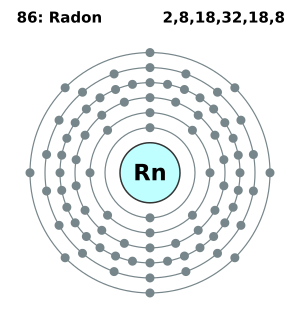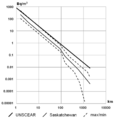Radon facts for kids
Radon is a special element, number 86 on the periodic table. Its symbol is Rn. It is a gas and belongs to a group called noble gases. These gases are unique because they usually do not mix or react with other elements. This means you often find radon all by itself.
Contents
What is Radon?
Radon is a chemical element. It is a colorless, odorless, and tasteless gas. Because it is a noble gas, it does not easily form chemical bonds with other elements. This makes it hard to detect without special equipment.
Why is Radon Dangerous?
Radon is radioactive. This means it gives off harmful rays as it breaks down. These rays can damage the cells in your body. High levels of radon can be very dangerous, especially if you breathe it in.
Radon in Homes
Radon can get trapped in houses, especially in older homes or basements. It comes from the natural breakdown of uranium in soil and rocks. When radon gas builds up, people can breathe it in without knowing.
When radon enters your lungs, it can get stuck there. Over time, this can cause serious health problems. It has been linked to cancer, especially lung cancer.
Staying Safe from Radon
Many groups work to help people check for radon in their homes. They want to make sure houses are safe and free from dangerous radon levels. You can test your home for radon to keep your family safe.
Related pages
| Periodic table | |||||||||||||||||||||||||||||||||||||||||
|---|---|---|---|---|---|---|---|---|---|---|---|---|---|---|---|---|---|---|---|---|---|---|---|---|---|---|---|---|---|---|---|---|---|---|---|---|---|---|---|---|---|
| H | He | ||||||||||||||||||||||||||||||||||||||||
| Li | Be | B | C | N | O | F | Ne | ||||||||||||||||||||||||||||||||||
| Na | Mg | Al | Si | P | S | Cl | Ar | ||||||||||||||||||||||||||||||||||
| K | Ca | Sc | Ti | V | Cr | Mn | Fe | Co | Ni | Cu | Zn | Ga | Ge | As | Se | Br | Kr | ||||||||||||||||||||||||
| Rb | Sr | Y | Zr | Nb | Mo | Tc | Ru | Rh | Pd | Ag | Cd | In | Sn | Sb | Te | I | Xe | ||||||||||||||||||||||||
| Cs | Ba | La | Ce | Pr | Nd | Pm | Sm | Eu | Gd | Tb | Dy | Ho | Er | Tm | Yb | Lu | Hf | Ta | W | Re | Os | Ir | Pt | Au | Hg | Tl | Pb | Bi | Po | At | Rn | ||||||||||
| Fr | Ra | Ac | Th | Pa | U | Np | Pu | Am | Cm | Bk | Cf | Es | Fm | Md | No | Lr | Rf | Db | Sg | Bh | Hs | Mt | Ds | Rg | Cn | Uut | Fl | Uup | Lv | Uus | Uuo | ||||||||||
|
|||||||||||||||||||||||||||||||||||||||||
Images for kids
-
Emission spectrum of radon, photographed by Ernest Rutherford in 1908. Numbers at the side of the spectrum are wavelengths. The middle spectrum is of Radium emanation (radon), while the outer two are of helium (added to calibrate the wavelengths).
See also
 In Spanish: Radón para niños
In Spanish: Radón para niños







